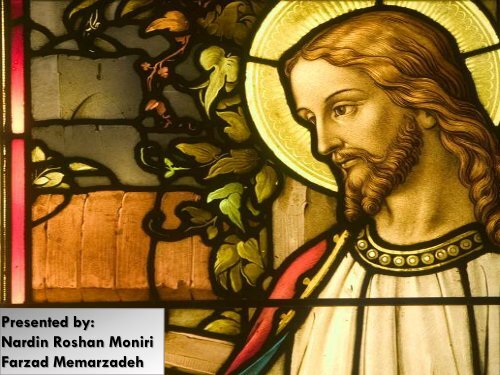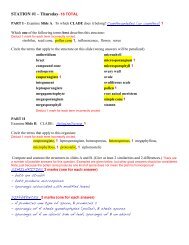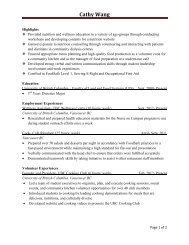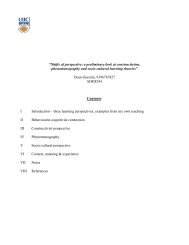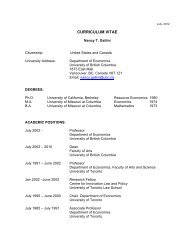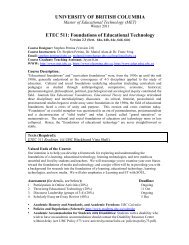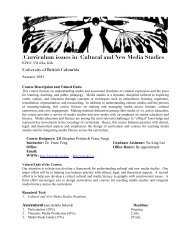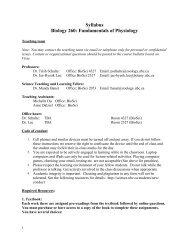Vank Church - UBC Blogs
Vank Church - UBC Blogs
Vank Church - UBC Blogs
Create successful ePaper yourself
Turn your PDF publications into a flip-book with our unique Google optimized e-Paper software.
Presented by:<br />
Nardin Roshan Moniri<br />
Farzad Memarzadeh
Overview Of Today’s Presentation<br />
History of Christianity<br />
Safavid Dynasty<br />
Replacement of Armenians from Old Julfa to New Julfa<br />
Brief overview of churches in Iran<br />
<strong>Vank</strong> Cathedral<br />
<strong>Vank</strong> Architecture
Christianity in Iran (Parthian):<br />
Christianity arrived in Iran during the Parthian (Ashkanian)<br />
period.<br />
Parthian Kings were tolerant of other religions and<br />
Christianity kept slowly but steadily advancing in various<br />
parts of the empire.<br />
At the time of the persecution of Christians in Rome many<br />
sought refuge in Iran and were given protection by the<br />
Iranian rulers. Though thousands of Persians embraced<br />
Christianity, Persia remained Zoroastrian with many adhering<br />
to the Cult of Mithra
History of Christianity (Sassanian):<br />
With Sassanian (A.D. 226-641), Christianity (and other<br />
religions) suffered resentment.<br />
When the Roman emperor Constantine made Christianity the<br />
state religion in Rome (AD 312) and himself the sovereign of<br />
all Christians, the new fate became associated with Iran's<br />
archenemy.
History of Christianity, Continue…<br />
Conversion of Armenians into Christianly and defection of<br />
some Armenian army units to Rome made the matters<br />
worse. Religious and national feelings were united and<br />
paved the ground for future persecutions that continued in<br />
Persia for a century after they had ceased in Rome, where<br />
they started in the first place
History of Christianity (Safavid Dynasty):<br />
Who<br />
When<br />
Where<br />
Their impact
Question:<br />
1)Why did Armenians move to Iran initially<br />
2) From which region of the world they are originally from<br />
3) Who was the mastermind behind their migration
Impact of Iranian kings on Christianity:<br />
During the reign of Shah Abbas, the Safavid king, his wise<br />
policies caused a sizable number of Armenians from Armenia<br />
and Azarbaijan to transfer and settle in Isfahan and other<br />
regions of Iran such as shiraz and Gilan.<br />
After the death of Shah Abbas the First, his successor, Shah<br />
Abbas the Second, also paid close attention to the welfare of<br />
Armenians and more churches were erected in Jolfa.<br />
The influx of many Europeans during the reign of the Qajars<br />
led to the flourishing of other churches, in addition to those<br />
that were constructed previously.
Bethlehem <strong>Church</strong> in Esfahan:
Saint Stephanos church in Azarbaijan:
Saint Mary's church in Jolfa Isfahan:
Sare Jouye Armaneh in Shiraz:
Are you ready for a journey<br />
back to Iran to see an<br />
architectural phenomena<br />
What are you waiting for<br />
Pack up your bags and lets<br />
go!!!<br />
<strong>Vank</strong> Cathedral
Question:<br />
What does <strong>Vank</strong> mean and which language has given rise to<br />
this word initially<br />
• <strong>Vank</strong> means “Cathedral” and it originally came from<br />
Armenian language.<br />
• According to Farsi dictionary:<br />
Cathedral = Kelisa Jamee
Jolfa:<br />
Jolfa is the Armenian and Christian quarter of Isfahan which<br />
was established in 1603 during Shah Abbas I Safavid.<br />
Jolfa is on the south bank of the Zayandeh River and is linked<br />
to the Muslim part of Isfahan by Sio-se-pol bridge.<br />
The town of Jolfa on the Araxes River in Azarbaijan (now on<br />
Iran's northern border) at one time was the major Armenian<br />
settlement until Shah Abbas I imported Armenian families to<br />
new Jolfa in Isfahan.<br />
Today, Jolfa is a quiet suburb part of Isfahan with<br />
predominantly Christian community.
<strong>Vank</strong> <strong>Church</strong> Overview:<br />
<strong>Vank</strong> Cathedral is also known as The <strong>Church</strong><br />
of the Saintly Sisters.<br />
At the beginning of the 17th century in 1606<br />
during Safavid period, work on the cathedral<br />
began.<br />
However, in 1655, this Armenian church was<br />
rebuilt as the Christian community was rapidly<br />
growing in Isfahan.<br />
under the control of Archbishop David, the<br />
church was completed.
<strong>Vank</strong> external view:<br />
The <strong>Vank</strong> Cathedral, comprises<br />
of a domed sanctuary such as a<br />
Persian mosque.<br />
However, with the important<br />
addition of a semi-octagonal<br />
apsis and raised chancel, <strong>Vank</strong><br />
Cathedral, acquires western<br />
styles too.<br />
The exteriors of <strong>Vank</strong> Cathedral,<br />
are in comparatively<br />
contemporary brickwork and are<br />
outstanding<br />
The exterior of this cathedral is<br />
compared equal to its richly<br />
festooned interior.<br />
apse: a domed or vaulted recess or projection on a<br />
building especially the east end of a church; usually<br />
contains the altar
<strong>Vank</strong> Internal View:<br />
The interior of <strong>Vank</strong> Cathedral is embellished with<br />
some excellent paintings and gilded carvings.<br />
•It comprises a wainscot of rich tile work<br />
The precisely blue and gold engraved central<br />
dome portrays the Biblical story of origin of the<br />
world and expulsion of man from Eden<br />
There are decorations with a markedly Armenian<br />
motif of a cherub chief enclosed by folded wings.<br />
The ceiling above the entrance is also designed<br />
with delicate floral carving in Persian miniature<br />
style.
<strong>Vank</strong> Courtyard:
<strong>Vank</strong> Courtyard:<br />
The courtyard of <strong>Vank</strong> Cathedral, comprises<br />
a huge agnostic belfry over the graves of<br />
both Protestant and Orthodox Christians.<br />
A tile work sign autographed in Armenian<br />
can be seen by the doorway to the cathedral<br />
All the graves are placed along the exterior<br />
wall of the entrance including Armenian<br />
inscriptions<br />
At the corner of the courtyard, you can see a<br />
raised area with a memorial of 1915<br />
Armenian massacre in Turkey.
<strong>Vank</strong> Museum:<br />
The museum of Armenian culture is the building<br />
next to the cathedral.<br />
The museum displays 700 handwritten books, the<br />
first book printed in Iran, a variety of objects<br />
related to Armenian community in Isfahan such as<br />
Safavid costumes, tapestries, European paintings<br />
brought back by Armenian merchants , embroidery,<br />
and other ethnological displays related to<br />
Armenian culture and religion.<br />
There are several carved stones showing scenes<br />
from the Bible outside the museum.
<strong>Vank</strong> Library:<br />
The library of <strong>Vank</strong> Cathedral, comprises more than 700 handwritten books and lots of precious and<br />
exclusive resources for study in Armenian and medieval European languages and arts
THANK YOU!


